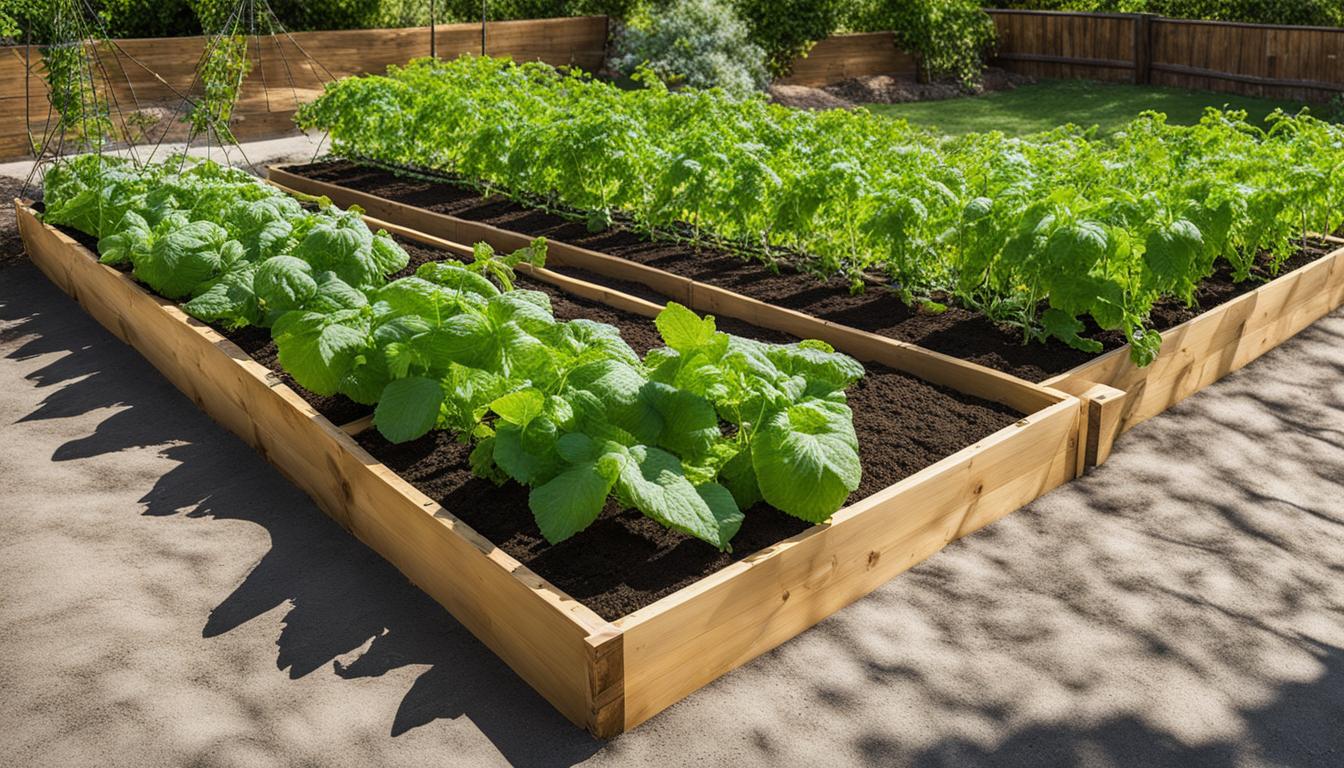
When it comes to growing climbing vegetables in your garden, having the right plant supports can make a world of difference. From trellises to cages, there are various options available to help your plants grow vertically and thrive.
In this article, I will explore the best plant supports for climbing vegetables and provide some tips on how to use them effectively in your vegetable garden.
Key Takeaways:
- Trellises and cages are common plant supports for climbing vegetables.
- There are various types of trellises available, such as plastic, chicken wire, and galvanized fencing.
- Supporting melons on trellises can prevent premature fruit slippage.
- Beans and peas can be grown on trellises using lightweight netting or vertical cords made of sisal twine.
- Tomato plants can be supported with stakes or tomato cages, depending on the variety.
Types of Trellises for Vine Crops
Trellises are an excellent option for supporting vine crops such as squash, melons, and cucumbers. They come in different types and materials, offering versatility to suit your garden needs. Here are some popular types of trellises:
- 1. Trellis Netting: Made from durable material, trellis netting provides a sturdy support system for heavy-fruited and vigorous crops. The netting can be easily attached to supports using nails, staples, plastic ties, or wire.
- 2. Plastic Trellis: Lightweight and affordable, plastic trellises are an ideal choice for smaller vine crops. They can be easily installed and provide adequate support for the plants.
- 3. Chicken Wire: Chicken wire trellises offer excellent support and allow better airflow, reducing the chances of fungal diseases. They are suitable for a wide range of climbing vegetables.
- 4. Galvanized Fencing: Strong and durable, galvanized fencing makes for a robust trellis option. It is perfect for larger vine crops that require substantial support.
When choosing a trellis for your vine crops, consider the size and vigor of the plants, as well as your garden’s aesthetics. It’s important to secure the trellis properly and provide adequate stability by pounding stakes deep into the ground. Some gardeners also prefer angling the trellises to maximize sunlight exposure and ease of harvesting.
Table: Comparison of Trellises for Vine Crops
| Trellis Type | Materials | Strength | Cost | Installation |
|---|---|---|---|---|
| Trellis Netting | Durable material | Strong | Affordable | Easy to attach using nails, staples, ties, or wire |
| Plastic Trellis | Lightweight plastic | Moderate | Low-cost | Simple installation |
| Chicken Wire | Metal wire mesh | Moderate | Cost-effective | Secure attachment required |
| Galvanized Fencing | Metal fencing | Very strong | Higher cost | Requires proper installation for stability |
By choosing the right trellis for your vine crops, you can provide the necessary support for healthy growth and optimize the use of space in your garden.
Supporting Melons on Trellises
Melons are delicious and refreshing fruits that can be successfully grown on trellises, providing several benefits for gardeners. However, melons have a tendency to “slip” from the vine when ripe, causing them to fall prematurely to the ground. To prevent this, it is important to support the developing fruit on the trellis using simple techniques.
A popular method to support melons on trellises is to create hammocks or slings using strips of cloth. These cloth strips should be tied loosely to the trellis wire, allowing the middle portion to form a sling where the fruit can rest. It is essential to tie the cloth strips securely but without constricting the fruit, as this could cause damage. The sling supports the weight of the melon, preventing it from slipping off the vine.
Supporting melons on trellises not only prevents melon slippage but also provides several advantages. By keeping the melons off the ground, they are protected from soil-borne diseases and pests, resulting in cleaner and healthier fruits. Additionally, supporting melons on trellises maximizes airflow and sunlight exposure, leading to better fruit development and ripening.
Pros and Cons of Supporting Melons on Trellises
| Pros | Cons |
|---|---|
| Prevents melon slippage | Requires additional time and effort for sling creation |
| Protects melons from soil-borne diseases and pests | Possible risk of damage to fruit if not supported correctly |
| Improves fruit cleanliness and quality | May need extra support for larger melons |
| Enhances airflow and sunlight exposure | Requires regular monitoring and adjustment of the slings |
By utilizing the proper support techniques, gardeners can successfully grow melons on trellises, enjoying healthy and flavorful fruits while minimizing the risk of melon slippage and other potential issues.
Growing Beans and Peas on Trellises
When it comes to growing beans and peas, utilizing trellises can be a game-changer. These climbing vegetables thrive when given the proper support, and trellises offer an excellent solution.
Lightweight netting, vertical cords, and sisal twine are the go-to options for creating trellises that encourage healthy growth and maximize space in your vegetable garden.
To set up a trellis for beans and peas, start by choosing lightweight netting or sturdy wire mesh as your main support structure.
This material provides the perfect framework for the vines to twine up and grow. Additionally, vertical cords made from eco-friendly sisal twine or other natural fibers can be used to guide the plants along the trellis.
When installing your trellis, ensure it is placed at the same spacing between seeds or transplants as if they were growing on the ground. As the beans or peas grow, gently weave the growing tips between the openings in the netting or mesh every few days to train the vines.
This will encourage upward growth and prevent tangling or overcrowding, resulting in healthier plants and bountiful harvests.
Trellising Beans and Peas: Benefits and Considerations
There are several advantages to growing beans and peas on trellises. Firstly, trellising helps maximize the use of vertical space in your garden, allowing you to grow a larger quantity of vegetables in a limited area.
Secondly, when beans and peas climb on trellises, they are less likely to develop diseases that can occur when their foliage is in contact with damp soil. Lastly, trellising makes harvesting easier, as the plants are at a more accessible height, reducing strain on your back and knees.
Although, it’s essential to choose the appropriate trellising materials and techniques for optimal results. The lightweight netting and vertical cords mentioned earlier provide the necessary support without adding excessive weight or constraining the plants’ growth. Also, be sure to monitor the vines regularly to guide them along the trellis and prevent entanglement or damage.
| Trellising Method | Advantages | Considerations |
|---|---|---|
| Lightweight Netting | – Easy installation and removal – Provides a versatile support system – Allows good air circulation to prevent diseases | – Requires regular monitoring to guide vines – May need additional anchoring in windy conditions |
| Sisal Twine Vertical Cords | – Eco-friendly and biodegradable – Provides natural support for climbing plants – Easy to train vines along the cords | – Requires regular maintenance to prevent tangling – May need additional support as plants grow heavier |
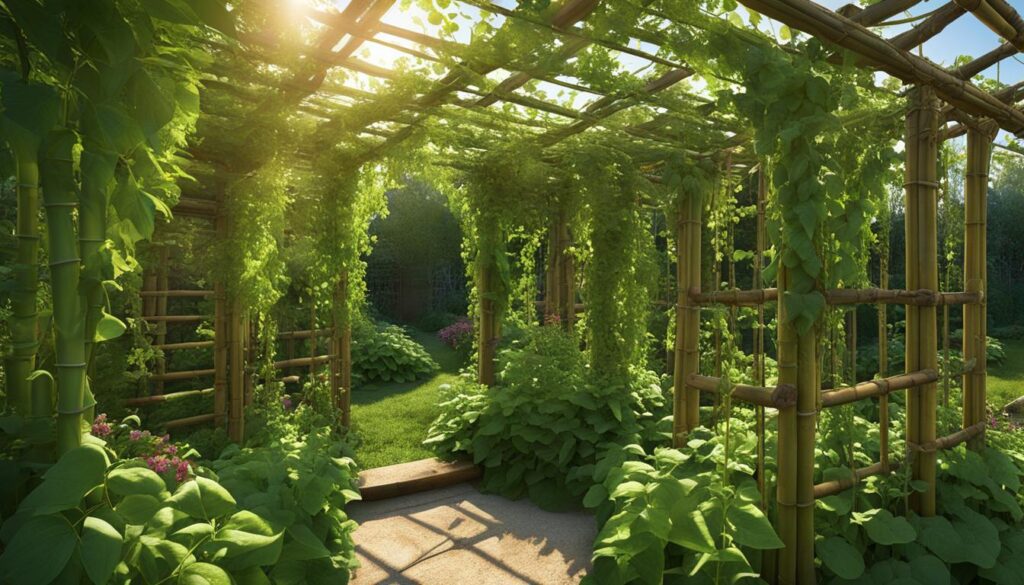
Supporting Tomato Plants with Stakes and Cages
When it comes to growing healthy and productive tomato plants, providing proper support is essential. Tomato plants, especially indeterminate varieties that continue to grow throughout the season, benefit from being supported and contained. There are two main options for supporting tomato plants: stakes and cages.
Tomato Stakes
Tomato stakes are vertical supports made of wood or metal that are driven into the ground next to the tomato plants. Staking tomato plants helps keep them upright and prevents sprawling. It also improves air circulation around the plants, reducing the risk of diseases like blight.
When using stakes, it is important to tie the tomato vines to the stake as they grow. Pruning is necessary to remove excessive foliage and create a more manageable plant.
Tomato Cages
Tomato cages are another popular option for supporting tomato plants. These cages are typically made of metal spirals or conical wire that surrounds the plant, providing all-around support. Tomato cages are especially beneficial for determinate varieties that grow to a certain height and stop.
For indeterminate varieties, taller and stronger cages may be necessary. The advantage of using cages is that they require less pruning and tying compared to staking. However, it is still important to monitor the growth of the plants and make sure they are properly supported within the cage.
Choosing between stakes and cages often depends on personal preference and the specific needs of the tomato variety. Both options can be effective in providing support and promoting healthy growth. It is important to regularly check the plants and make adjustments as needed to ensure they are well-supported throughout the growing season.
| Support Option | Advantages | Disadvantages |
|---|---|---|
| Tomato Stakes |
|
|
| Tomato Cages |
|
|
Homemade Tomato Cages from Cement-Reinforcing Mesh
When it comes to supporting tomato plants in your garden, homemade tomato cages made from cement-reinforcing mesh can be a cost-effective and practical solution.
Cement-reinforcing mesh is known for its strength and durability, making it an ideal material for constructing sturdy tomato cages that can support the weight of growing plants and their fruit.
To create your homemade tomato cages, you will need heavy-duty wire cutters or bolt cutters to cut the mesh into pieces. Once cut, the pieces can be connected together to form a cage shape.
The large four-inch square holes in the mesh allow for easy access to the plants and make harvesting a breeze.
It is important to install the homemade tomato cages when the tomato plants are still young and small, ensuring that they have proper support as they grow.
To secure the cages in place, stakes can be inserted inside the cages and pushed into the ground. This will provide additional stability and prevent the cages from toppling over as the plants grow taller.
Advantages of Homemade Tomato Cages from Cement-Reinforcing Mesh
There are several advantages to using homemade tomato cages from cement-reinforcing mesh in your garden. Firstly, they are a cost-effective option compared to purchasing pre-made cages.
Secondly, the strength and durability of the mesh ensure that the cages can withstand the weight of the plants and their fruit without bending or collapsing. Also, the large square holes in the mesh allow for easy access to the plants for pruning, harvesting, and other maintenance tasks.
| Advantages | Description |
|---|---|
| Cost-effective | Homemade tomato cages made from cement-reinforcing mesh are a budget-friendly alternative to pre-made cages. |
| Strong and durable | The mesh provides excellent support and can withstand the weight of growing plants and their fruit. |
| Easy access | The large square holes in the mesh make it easy to reach the plants for pruning, harvesting, and maintenance. |
By using homemade tomato cages made from cement-reinforcing mesh, you can provide your tomato plants with the support they need to grow strong and produce a bountiful harvest. These cages are not only functional but also a cost-effective and durable solution for any home gardener.
Using Canes, Poles, and Stakes as Plant Supports
When it comes to providing support for vine vegetables in your garden, canes, poles, and stakes are simple yet effective options. These plant supports can be easily pushed into the ground at the base of your plants, providing the necessary vertical structure for them to climb and grow.
Canes and poles can be arranged in rows or in a wigwam or tepee shape, depending on your preference and the needs of your plants.
To create a sturdy support system, you can tie the canes, poles, or stakes together using string, twine, or wire. This will help create a rigid structure that can withstand the weight of the climbing vegetables.
Canes and poles provide a natural and rustic look to your garden, while stakes offer a more minimalistic and compact option.
These plant supports are particularly suitable for vining vegetables such as peas, beans, and squash. As your plants grow, they will naturally start to climb and twine around the canes, poles, or stakes, providing stability and allowing for better air circulation. This, in turn, can help reduce the risk of diseases and improve the overall health and productivity of your plants.
Benefits of Using Canes, Poles, and Stakes as Plant Supports
There are several benefits to using canes, poles, and stakes as plant supports:
- Cost-effective: Canes, poles, and stakes are affordable options for providing vertical support to your plants.
- Easy to install: These plant supports can be easily pushed into the ground, making them quick and convenient to set up.
- Reusable: Canes, poles, and stakes can be used season after season, providing long-term support for your climbing vegetables.
- Space-saving: Canes, poles, and stakes take up minimal space in your garden, allowing you to maximize your growing area.
By using canes, poles, and stakes as plant supports, you can ensure that your vine vegetables grow in a structured and organized manner, promoting healthier plants and a bountiful harvest.
Comparison of Canes, Poles, and Stakes as Plant Supports
| Plant Support | Advantages | Disadvantages |
|---|---|---|
| Canes | Provide a natural and rustic look to the garden Easy to work with and arrange Reusable | May require additional tying or support depending on plant weight and growth |
| Poles | Sturdy and durable Can provide a taller support system Reusable | May require digging holes for installation Can be more challenging to handle and transport |
| Stakes | Compact and space-saving Easy to install and move Reusable | May require additional tying or support depending on plant weight and growth |
Trellising Options for Climbing Plants
Trellises are a versatile and flexible option for providing support to climbing plants. They can be attached to walls, fences, or left freestanding. Trellis panels made from wood, metal, or plastic can be used to create an instant support system for vining vegetables.
Mini-trellises can be made by tying lengths of cane together and are perfect for individual squash or marrow plants. There are plenty of off-the-shelf trellis options available, as well as DIY solutions using materials from home improvement stores.
Types of Trellises
When choosing a trellis for your climbing plants, consider the material and design that best suits your needs. Here are some common types of trellises:
- Wooden trellis: Adds a natural and rustic look to your garden.
- Metal trellis: Provides durability and a modern aesthetic.
- Plastic trellis: Lightweight and easy to install.
Whether you opt for a trellis panel, a trellis frame, or a mini-trellis, make sure it is sturdy enough to support the weight of your climbing plants as they grow.
Comparison of Trellis Materials
| Trellis Material | Pros | Cons |
|---|---|---|
| Wooden Trellis | Natural look, easy to customize | Can rot over time, may require maintenance |
| Metal Trellis | Durable, modern aesthetic | Can be expensive, may rust if not treated |
| Plastic Trellis | Lightweight, affordable | Less sturdy than wood or metal |
Consider the pros and cons of each trellis material to determine which one suits your needs and preferences.
Unique and Stylish Climbing Plant Supports
When it comes to supporting climbing plants in your garden, why settle for ordinary when you can have something truly unique and stylish? Metal plant supports offer both functionality and aesthetic appeal, making them an ideal choice for adding a touch of elegance to your outdoor space.
An iron trellis with a gothic archway design is a stunning option for showcasing your climbing plants. This type of trellis not only provides the necessary support for your plants, but it also adds a touch of architectural beauty to your garden. Its intricate curves and ornate details create a focal point that will surely impress your guests.
If you’re looking for something even more eye-catching, consider a steel obelisk. These tall, pyramid-shaped structures command attention and create a sense of verticality in your garden.
They provide sturdy support for your climbing plants while adding a bold and modern touch to your outdoor decor.
To create a cohesive look in your garden, you can even opt for a decorative obelisk trellis set. This set includes multiple obelisks of varying heights, allowing you to create a visually appealing display.
Whether you choose a classic black finish or a rust-resistant powder-coated option, these trellises will make a stylish statement in your garden.
Unique and Stylish Climbing Plant Supports
| Plant Support | Material | Design | Aesthetic Appeal | Durability |
|---|---|---|---|---|
| Iron Trellis with Gothic Archway | Iron | Gothic archway | High | Excellent |
| Steel Obelisk | Steel | Obelisk | High | Superior |
| Decorative Obelisk Trellis Set | Steel | Obelisk | High | Exceptional |
Durable and Functional Plant Supports
When it comes to providing long-lasting support for climbing vegetables, steel plant supports are a top choice. The durability and functionality of steel make it an excellent material for plant trellises, arches, and maypoles.
With their sturdy construction, they are designed to withstand the elements and support the growth and development of your plants.
Steel trellises offer a reliable and secure framework for climbing vegetables such as beans, peas, and cucumbers.
These trellises can be easily installed in your garden and provide a strong support system for your plants to grow vertically. Whether you choose a simple A-frame design or an intricate lattice pattern, steel trellises are built to last.
If you’re looking for an elegant focal point in your garden, a steel arch is a perfect choice. With its graceful curves and sturdy structure, a steel arch provides both support and visual appeal.
You can train climbing vegetables like tomatoes or flowering vines to grow up and over the arch, creating a stunning display.
For a unique and charming touch, consider a steel maypole. These freestanding supports offer a whimsical look while providing reliable support for vertical growth.
Whether you’re growing sweet peas or morning glories, a steel maypole adds a touch of magic to your garden.
Steel plant supports often come with a natural finish that adds a rustic look to your garden. However, if you prefer a different aesthetic, many supports can be powder-coated in a variety of colors. This allows you to customize the look of your plant supports to match your garden’s style.
FAQ
What are the best plant supports for climbing vegetables?
The best plant supports for climbing vegetables include trellises, cages, stakes, canes, poles, and metal frames. These supports provide vertical structure and stability for climbing plants such as peas, beans, tomatoes, cucumbers, squash, and melons.
What types of trellises are suitable for vine crops?
Vine crops like squash, melons, and cucumbers can be supported by trellises made of materials such as plastic, chicken wire, or galvanized fencing. It is recommended to choose a heavier mesh for larger-fruited and more vigorous crops. Trellises should be attached to supports securely using nails, staples, plastic locking ties, or wire.
How can I support melons on trellises?
To prevent melons from slipping off the vine when ripe, you can create hammocks or slings using strips of cloth. Tie the cloth strips loosely to the trellis wire, allowing the middle portion to form a sling where the fruit can rest securely.
How can I grow beans and peas on trellises?
Beans and peas can be grown on trellises using lightweight netting, sturdy wire, or vertical cords made from untreated sisal, cotton, or hemp. Place the trellis at the same spacing between seeds or transplants as if they were growing on the ground. Train the vines by gently weaving the growing tips between the openings in the mesh every few days.
How can I support tomato plants?
Tomato plants, especially indeterminate varieties, benefit from support and containment. You can use stakes made of wood or metal to provide support, ensuring you prune and tie the plants to the stakes as they grow. Tomato cages made of metal spiral or conical wire are also commonly used, with determinate varieties requiring commercial tomato cages and indeterminate varieties needing taller and stronger cages.
How can I make homemade tomato cages from cement-reinforcing mesh?
Cement-reinforcing mesh is a popular material for homemade tomato cages due to its strength and large square holes. Cut the mesh into pieces and attach them together using heavy-duty wire cutters or bolt cutters to form cages. Secure the homemade cages in place with stakes inside the cages while the tomato plants are still young and small.
How can I use canes, poles, and stakes as plant supports?
Canes, poles, and stakes are simple and affordable plant supports that can be pushed securely into the ground at the base of plants. They provide vertical support and can be arranged in rows or in a wigwam or tepee shape. These supports are suitable for vining vegetables like peas, beans, and squash.
What are the options for trellising climbing plants?
Trellises are versatile and flexible options for providing support to climbing plants. They can be attached to walls, fences, or left freestanding. Trellis panels made from wood, metal, or plastic can be used to create an instant support system for vining vegetables. Mini-trellises made by tying lengths of cane together are perfect for individual squash or marrow plants. There are also plenty of off-the-shelf trellis options available, as well as DIY solutions using materials from home improvement stores.
Are there unique and stylish climbing plant supports available?
Yes, there are many unique and stylish climbing plant supports available. Steel obelisks, iron trellises with gothic arches, and decorative obelisk trellis sets are all options that provide both structural support and aesthetic appeal to the garden. Some supports are made from rust-resistant materials or have a powder-coated finish to withstand weather conditions and enhance durability.
What are durable and functional plant supports?
Steel plant supports, including steel arches, trellises, and maypoles, are sturdy options that offer durability and functionality. These supports can be powder-coated or left with a natural finish, depending on the desired aesthetic. Designed to withstand the elements, they provide long-lasting support for excellent growth and development of climbing vegetables.

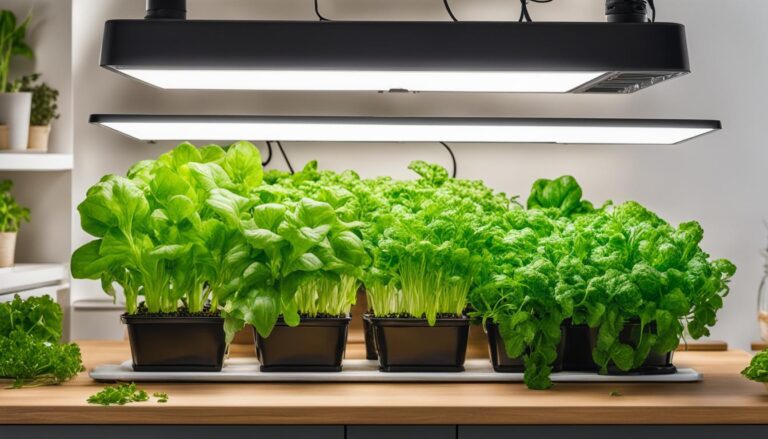
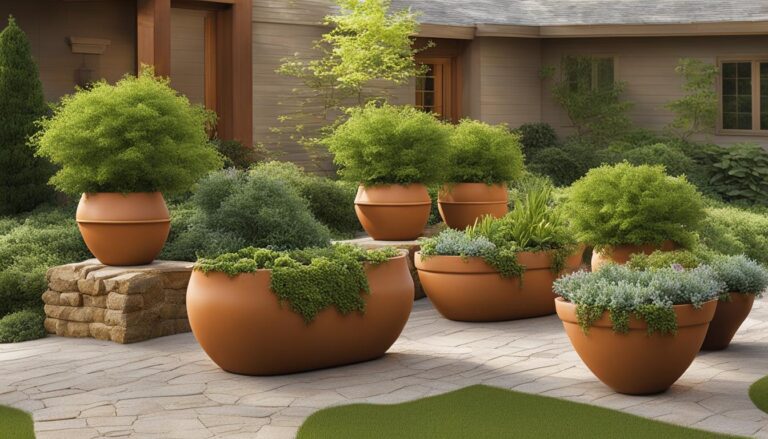
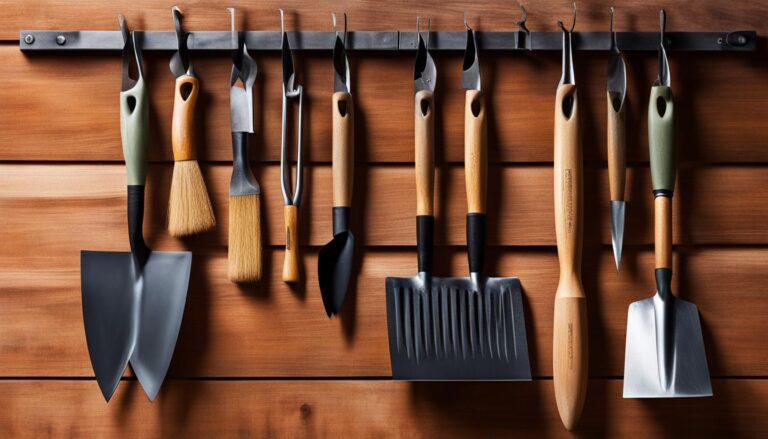
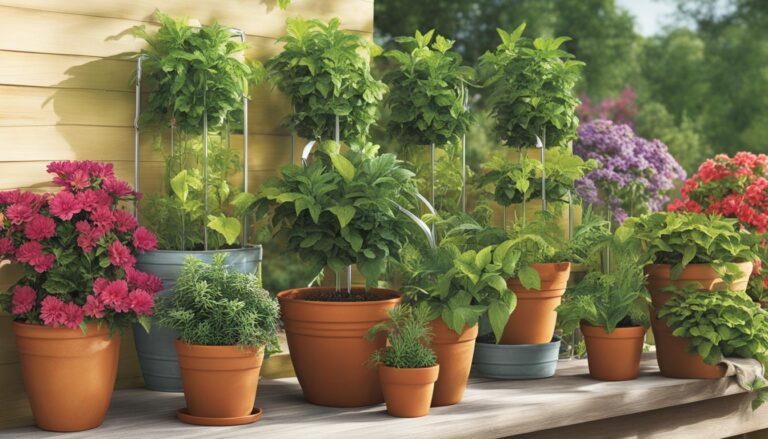
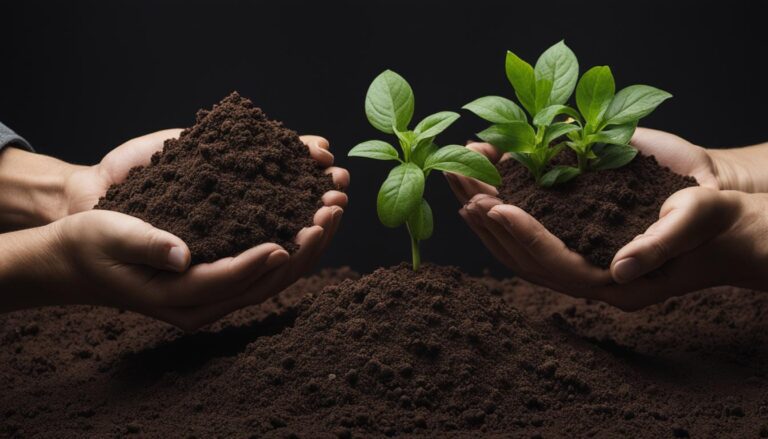
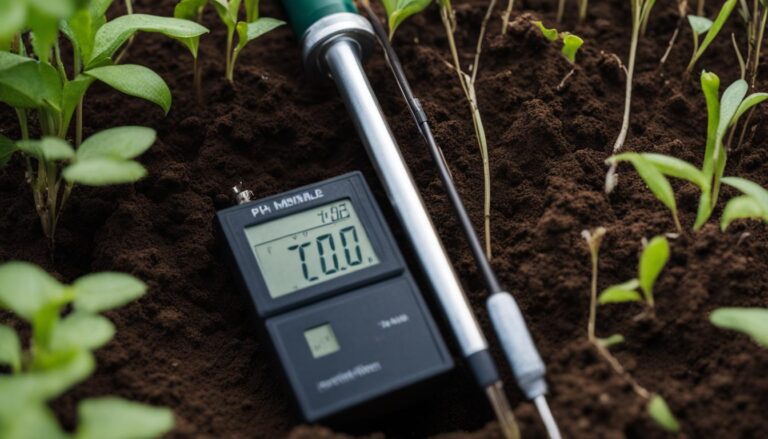
2 Comments